
In early November I ventured down to the shoreline of Mono Lake below the Tioga Lodge to use my former-biologist eyes to assess the damage done to State Park land and Post Office Creek.
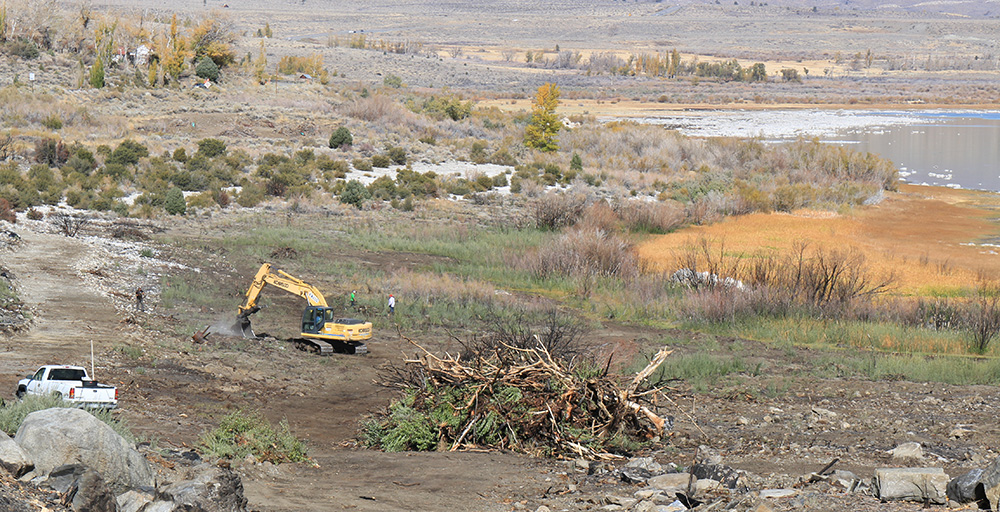
It was interesting to contrast the damage caused by the Marina Fire with the damage caused by heavy machinery; I’m sure the combination of the two events is even more detrimental. While I made observations and took photographs, I was especially concerned by two things—the bird habitat adjacent to the excavation and the wide swath of flood water rushing down from what used to be a creek channel that now spreads the water across the landscape haphazardly on it’s way to Mono Lake.
Habitat and birds
The Marina Fire burned all the way to the edge of the lake in most places below the Tioga Lodge property, so a lot of the plant life that is there now is new growth willows and invasive species (e.g. mullein and thistles) that pop up first after a disturbance like fire. There is a wetland to the north of the property that did not burn but the excavations butt right up to it—thick, mossy, very wet terrain that takes years to develop, with a dense stand of cattails. This was mostly, if not all, left untouched by the heavy machinery, thankfully. The cleared areas that were willow habitat recovering from the fire (2+ acres) are bare and the root systems are torn and substantially damaged. I’m not sure how the damage from the machinery will affect the willows in the long term, but it looks like it might take a bit longer than in the case of only a natural disturbance for the willows to return in those ripped up-areas. Though the fire did burn these areas down to bare soil, they would eventually recover on their own from dormant seeds and root sprouts—they may have looked barren, but were truly bursting with impending life.
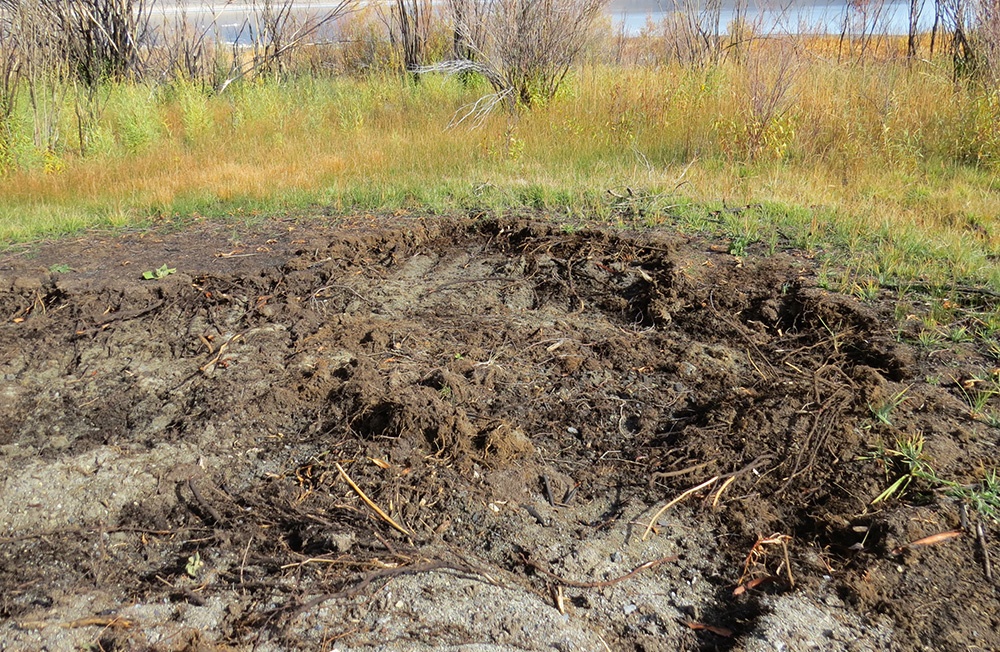
I heard a few birds while down by the wetland, but November is not the best time to assess bird use of the area since most birds have flown to warmer climes for winter. Local Point Blue Conservation Science biologist Kristie Nelson offered a list of birds that have been seen in the area between Post Office Creek and the Mono Inn, compiled from citizen science data (eBird) and anecdotal sightings going back 100 years. Nelson’s compilation of species showed 64 species using the area around Post Office Creek, 11 of which are considered rare.
This area used to be a thick jungle of willows, perfect habitat for Willow Flycatchers (Empidonax traillii), which were once common breeders in the Mono Basin’s healthy riparian habitats, and are now extirpated from Rush Creek and rarely seen in the Mono Basin except during migration. Their numbers dropped as habitat east of Highway 395 was developed and fragmented, and with the increase in the region of nest parasites like Brown-headed Cowbirds.
Mono Lake County Park, just to the north of this particular stretch of habitat, is an area where migrating birds take refuge and forage for food on their migration journey after traveling through a sea of sagebrush, and as they move south, having a continuous swath of healthy lake edge and riparian habitat is safer and easier than flying over dry, empty space. Willows provide food, shelter, and safety. Breeding birds depend on returning from their winter homes to find this essential habitat intact. This is why protecting habitat, even the smallest area, is important.
Flooding and erosion
I followed what I assumed to be the or one of the now-dry Post Office Creek stream channels—it was about a foot deep with a substantial layer of organic matter on the top with well-established rootlets and a corridor of riparian plants (now burned or cut) like wild rose (Rosa woodsii), goldenrod (Solidago californica), mugwort (Artemisia ludoviciana) and willow (Salix spp.). It was dry, filled with debris from the burn and the highway (trash).
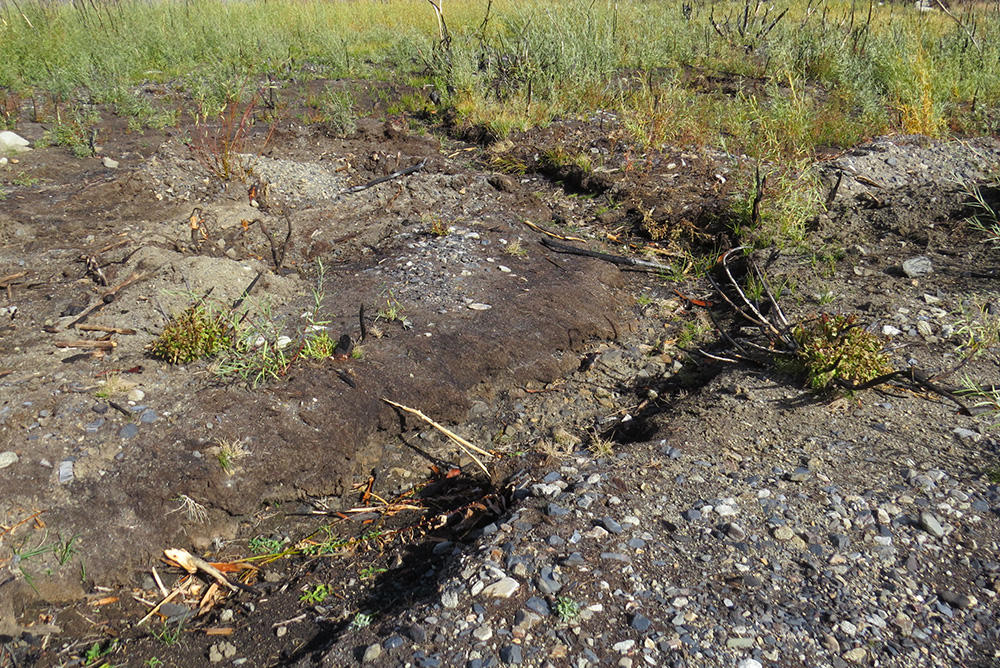
I’m more concerned about where the water is now rather than where it is not. The new “channels” are flooding the recently-burned area, which is at such a slope that the water is running off and carrying essential topsoil down towards Mono Lake. This will likely impede the vegetation from restoring itself without human aid. This stripping of a large swath of ground is troublesome. If the area of land were flatter, it might be creating more wetland habitat, but since it is at a slope that pushes all the water downhill at a relatively rapid rate, it will only continue to degrade the soil that has been fried by fire and has no erosion control in the form of established root systems. The creek needs to be channelized again to protect the area from excessive erosion. The water now flows into the lake in two smaller channels farther south than the original channel and farther from the wetland area, and also in a 30-meter-wide sheet along the shore.
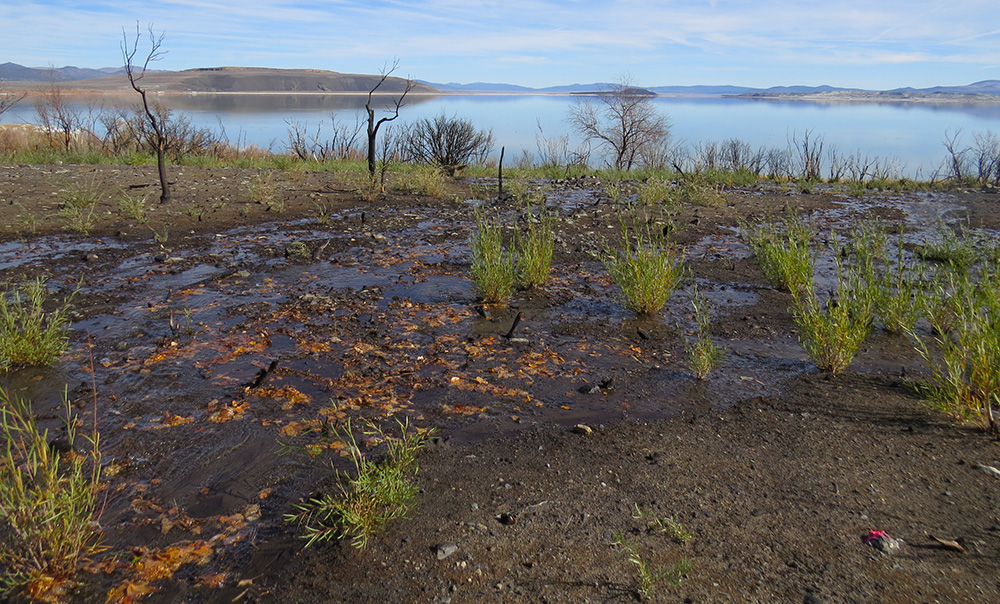
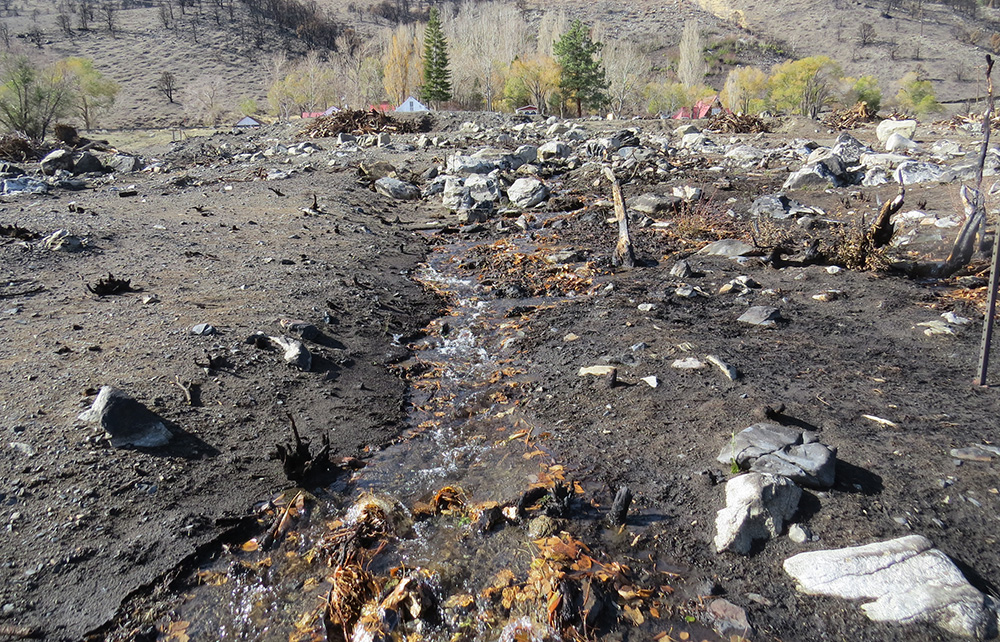
This earth is fragile yet resilient. Ecosystems have a way of bouncing back on their own from occurrences like fires and floods, but damage can be compounded by human activity. It is important that we do our part to protect what is left. Even the smallest riparian corridors offer complex and vital habitat for birds and other animals.

Thank you for your thorough description of the damage done by the heavy machinery below the Tioga Lodge. What were they thinking??!!
Your information will be very useful in following the hoped-for recovery of the area over the next few months, but the erosion caused by the abnormal
water flows may impede the restoration of the plant life.
We’ll see.
Peter
I would have most harsh words of expression toward those responsible for the damage.
“What the … were you thinking?!” comes to mind, most likely with a strong emphasis on the missing word. Growing older allows me to grow a bit more blunt of displayed stupidity!
So, what were they:
(1) thinking?
(2) thinking they could get away with, in “plain sight”?
(3) knowing of the boundary line to state-protected lands?
For their bold plans and bull-minded intentions, I hope they appreciate and willingly accept the civil, and maybe criminal, repercussions of their choice of actions.
Maybe they’ll learn something. Maybe?
Has anyone asked them why they were bulldozing property that didn’t belong to them? I mean, what was their intended goal with the bulldozing?
They probably had in mind mitigation of risk from future fire activity, but I don’t really know. Maybe they even thought they were being good stewards and cleaning up the mess created by the fire. Maybe the drainage alterations were only temporary and they had a plan to restore the creek channel once they were done with the work, but we will never really know since the work was interrupted.
Having been there in August, I could see that Tioga Lodge escaped destruction by a thin margin.
I doubt the owners have deep pockets and I wonder what will become of the soon to be abandoned property once their ritual crucifixion is accomplished. All the blood thirsty calls for “civil and maybe criminal repercussions” make me sad that folks are so mean spirited.
I had a conversation with Norman Dechaine a couple of years ago in which he expressed his concern that the MLC had gone too far beyond its original mission of restoring water flow to the lake and had morphed into another “wilderness preservation” organization funded by donations from prosperous tourists who had passed through the area and thought it would be really nice if human economic uses of the lake basin were eliminated so the area would become “pristine”.
I count myself among those tourists and have written checks to the MLC for many years, but I’m not so sure I’ll continue to do so.
The Tioga Lodge owner has expressed a desire to build a campground on the land, so removing the burned vegetation is an attempt to clear the area for that purpose, we’ve heard. The State Reserve boundary was marked and the operator should have had no problem avoiding going that low, though this land owner has expressed an opinion in the past that her property claim should go all the way to the lakeshore, disputing the State’s ownership.
I see. That does put a bit of a spin on things.
Was that construction specialty’s excavator?
Has not anyone contacted the owner of Tioga Lodge and inquired about PERMITS for work that was to be done. Does her property claim include the area being worked in? If State Boundary was marked then the contractor should be held responsible, did they not do a pre job meet with State and property owner and MLC? If not then who failed in the communication process, did they have the required permits do the work ?
Steve,
No that was not Construction Specialty, but another contractor from out of the area.
Chuck,
We don’t know of any prior communication that took place with Mono County or the Mono Lake Tufa State Reserve. County and State Park staff said there were no permits. State Park staff repeatedly warned the contractor that he was working on/damaging State Park property, but the work continued after the ranger departed.
Best,
Bartshe